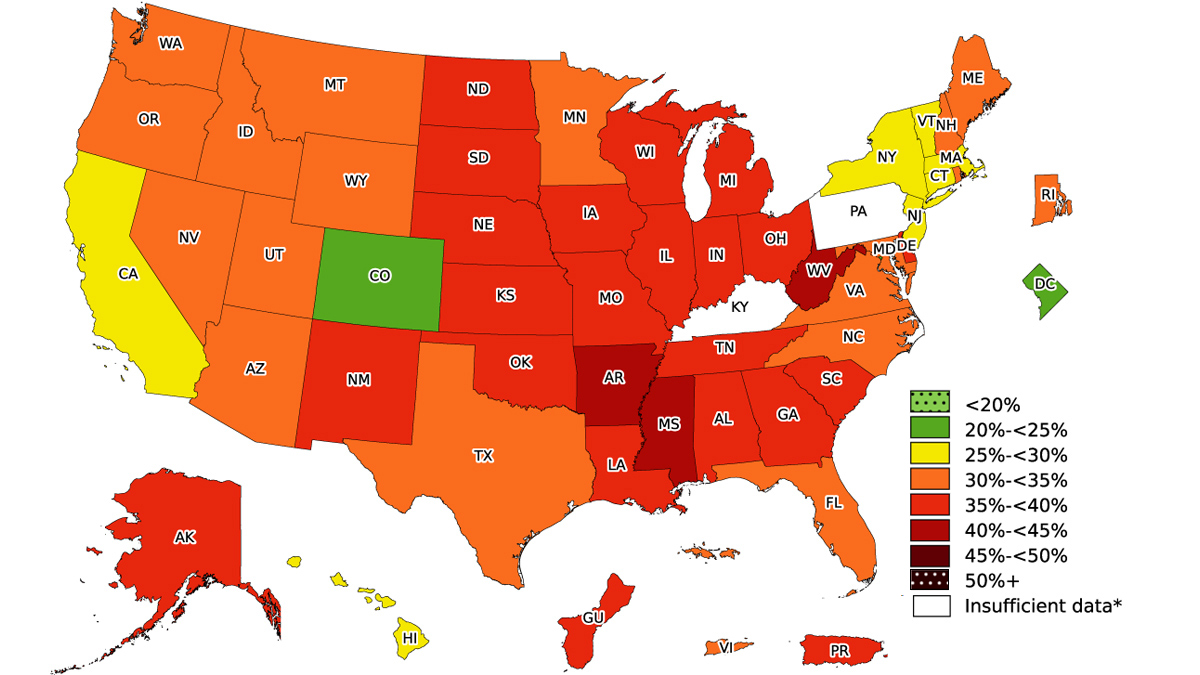What is Obesity?
Obesity is defined as “excess or abnormal fat accumulation that presents a risk to health”. The Centers for Disease Control and Prevention (CDC) defines it as “weight that is considered higher than what is considered healthy for a given height is described as overweight or obesity”. Although it is an imperfect measure, both use body mass index (BMI) to further define these terms, with a BMI of 25 to 29.9 kg/m2 considered overweight and =30 kg/m2 as obesity.
How prevalent is Obesity in the USA?
Based upon data collected for NHANES from 1988 to 1994, 1999 to 2000, and 2021 to 2023, the age-adjusted overall prevalence of obesity in the United States increased progressively from 22.9 to 30.5 to 40.3 percent . In 2021 to 2023, the prevalence of obesity was similar in adult males and females .
The 2023 Adult Obesity Prevalence Maps for 48 states, the District of Columbia (DC), and three U.S. territories show the proportion of adults with obesity.
The age-adjusted prevalence of class III obesity (body mass index ≥40 kg/m2), sometimes referred to as severe obesity, has risen from 5.7 to 9.2 percent between 2007 and 2020
Projections using extrapolated data from BRFSS and NHANES suggest that by 2030, almost half of all United States adults will have obesity, and almost one-fourth will have severe obesity .
The age-adjusted prevalence of class III obesity (body mass index ≥40 kg/m2), sometimes referred to as severe obesity, has risen from 5.7 to 9.2 percent between 2007 and 2020
Projections using extrapolated data from BRFSS and NHANES suggest that by 2030, almost half of all United States adults will have obesity, and almost one-fourth will have severe obesity .
What is the association of Obesity and other diseases?
Increasing body mass index (BMI, kg/m2), even within the normal range of BMI (21 to 24.9), is associated with an increased risk of type 2 diabetes, hypertension, coronary heart disease, and cholelithiasis. Panel A shows data for women in the Nurses’ Health Study, initially 30 to 55 years of age, who were followed for up to 18 years. Panel B shows data for men in the Health Professionals Follow-up Study, initially 40 to 65 years of age, who were followed for up to 10 years.

Data from: Willett WC, Dietz WH, Colditz GA. Guidelines for healthy weight. N Engl J Med 1999; 341:427.
A recent report released by the Milken Institute shows that the annual cost and the economic impact of obesity in the United States exceeds $1.4 trillion. This number includes costs associated with obesity treatment and obesity related conditions and costs associated with attendance and productivity at work as they relate to obesity.
We suggest that all adult patients be screened for overweight and obesity (Grade 2B). This is done by measuring body mass index (BMI). In addition, we suggest obtaining an additional anthropometric measure (eg, waist circumference) in those with BMI between 25 and 40 kg/m2 (Grade 2C) as abdominal adiposity (and associated risk) may not be captured in this BMI range.
In individuals with BMI ≥25 kg/m2 or abdominal obesity (waist circumference ≥35 in [88 cm] in females or ≥40 in [102 cm] in males, waist-to-hip ratio ≥0.90 in males or ≥0.85 in females, or waist-to-height ratio >0.5) we suggest further evaluation to assess overall risk status.Components of evaluation – The evaluation includes a history, physical examination, and measurement of fasting glucose (or glycated hemoglobin [A1C]), thyroid-stimulating hormone, liver enzymes, and fasting lipids. See your doctor to get screened and evaluated.
Sources:
- https://obesitymedicine.org/
blog/health-economic-impact-of-obesity/ - https://www.who.int/health-
topics/obesity#tab=tab_1 - https://www.cdc.gov/obesity/data-and-statistics/adult-obesity-prevalence-maps.html

